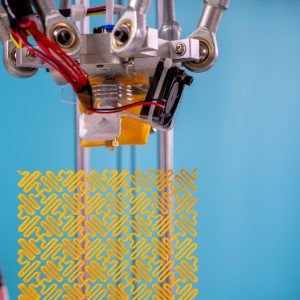
What is 3D Printing and Bioprinting?
3D printing is an essential component of Additive Manufacturing software (AM). This manufacturing method employs computer-automated manufacturing (CAM) processes to fabricate physical 3D objects layer by layer from computer-aided design (CAD) models. With 3D printing technology, objects are created by depositing materials onto a substrate. This technology is hugely versatile, as the deposited materials can be plastics, metals, powders, ceramics, liquids or living cells. The 3D printing process is accurate, repeatable, scalable, but also cost-effective for small production runs or even single prints of highly customized parts.
A subset of 3D printing used to produce natural tissues is called bioprinting. In this process, special biomaterial such as cells and growth factors are combined to form bioink.
History
The origins of 3D printing are in industrial applications, used in the 1980s and 90s for rapid prototyping as part of the design process. The first medical research applications were in 2002, with printing cells directly onto a synthetic scaffold to create miniature kidneys. 4 years later, using selective laser sintering machines, these materials were fused onto these scaffolds, allowing for more customization and higher yields. The next milestone was reached in 2008, when the first person was able to walk using a 3D printed prosthetic limb.
Market
The 3D printing industry is estimated to grow to approximately $6 billion by 2024, according to the 3D Printing Progress NEED SOURCE. Prosthetics, hip and knee replacements and other implants, tissue, medicines and hearing aids are expected to drive 3D printed products in life sciences and biotech.
Medical Applications for 3D Printing
Prosthetics
Because prosthetics were the first practical uses of 3D printing in the medical field, starting 11 years ago, these applications of the technology have made great progress. The current 3D printed patient-specific prostheses are enabling people who are missing limbs or have genetic deformities to lead normal and productive lives.
Implants
3D Printing has been used extensively in orthopedics, helping tens of thousands of people regain mobility with orthopedic hip and knee implants each year. Thanks to its low density and high strength, titanium is one of the most commonly used metals in human implants.
Tissue, Organs, Bones, Muscle and Skin
There have been tremendous advances in 3D printing technologies for a variety of human tissues, organs, bones, muscle and skin. These days, bones are routinely 3D printed from MRI or CT scans. For example, total talus replacements with a 3D printed metal talus bone allow patients to avoid loss of ankle-foot movement or amputation of the foot.
There are challenges to printing complex human organs like the heart and the brain as well as soft tissues, such as the uterus. Organ and complex structures are currently being 3D printed for medical research purposes. For example, researchers have been able to 3D print a “placenta on a chip”, with tiny cell cultures mimicking the structure and function of placenta, one of the least understood organs in the human body.
The future next step for this technology would be to print organs suitable to be used for human organ transplantation.
Medical Research
The 3D printing technologies, and especially the latest advancements in delicate direct cell printing, allow their use in medical research – for drug and therapy development and toxicity testing, and accelerate the research process. One example is using 3D printing to create tissues and organs to study how they are affected by cancer and other diseases. This technology also enhances collaboration between researchers and physicians, now that the physical objects can be shared via the internet as 3D printing instructions.
Surgical Planning
Surgical planning is the study of the anatomy and physiology of complex organs or anatomical structures in preparation for surgery. 3D printed models are used to assist surgeons to explore different approaches and practice before the actual surgery. The models could also be used in helping patients understand their condition and what to expect from surgery. Surgical planning with 3D printed models can significantly shorten the time of the procedure or operation, and improve patient experience and clinical outcomes.
Medical Education and Training
3D printing offers an effective substitute to the current practice of using human cadavers for medical education and training. With 3D printing technology, the human anatomy can be reproduced accurately from high resolution CT imaging and other sources, including multiple copies in different sizes that would be great advancement for medical education.
Drug Delivery
3D printing technology holds great promise in the field of drug delivery. Pharmaceuticals can be printed in personalized doses for each patient, with layering designed to provide immediate or sustained release of the medication to deliver a specific therapeutic effect. Additionally, technology to 3D print personalized drug delivery devices are currently in development.
Emerging Applications
Ligaments
Ligament injuries are pretty common and are difficult to treat. Scientists are working on creating 3D printed ligaments using a special electrospinning technique. Once this technology is perfected, 3D printed ligaments will become yet another addition to the medical arsenal.
Bionic Eye
Researchers are working on technology that could eventually lead to the development of the fully functional bionic eye. They 3D printed photoreceptors on a hemispherical surface, which is a precursor to the 3D printed eye that could one day be used to cure blindness.
Conclusion
The 3D printing technologies are accelerating and changing the fields of life science and medicine. The practical applications in medicine are ever-increasing and researchers are working on numerous new and potentially revolutionary applications. The precision, speed and cost effectiveness of 3D printing ushers a new era of personalized patient care.

